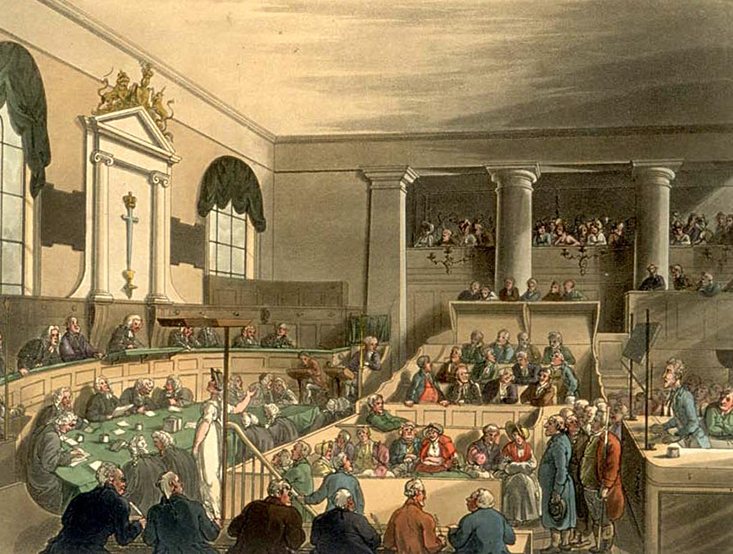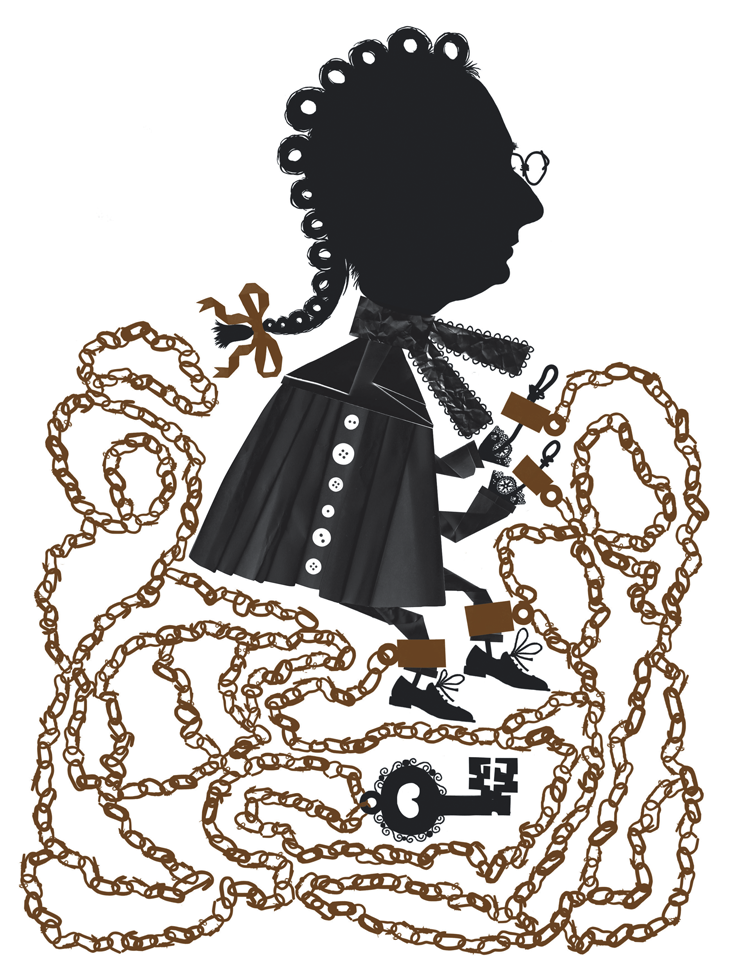The records of the Old Bailey, London’s central criminal court, tell the tale of one John Randal, who was tried on Sept. 9, 1674. He was charged “with two Indictments, one for Fellony for stealing several pieces of Plate, and other Goods…, and the other for Murder, Killing his House-Keeper.”
That his theft and his murder were described and tried together was natural for a world where the protection of property was a virtue at least on par with the promotion of human happiness. Nearly a hundred years later, in 1769, William Blackstone argued that it is quite reasonable to execute someone convicted of stealing “a handkerchief, or other trifle, privately from one’s person,” even though other crimes that involve goods of higher value are punished less severely.
Blackstone was writing the fourth and final volume of his Commentaries on the Laws of England, whose goal was to justify British justice using the most up-to-date moral reasoning found on the Continent.1 His conclusion was that 18th-century British law was “so highly finished, it is hard to speak with that praise, which is justly and severely its due.” Two hundred and fifty years later, though, it seems to us a savage thing, preoccupied with property and violent retribution, including both torture and death, rather than any process of intervention, education, or rehabilitation.
It is the responsibility of the historian to reveal the nature and causes of those changes which, although imperceptible in real time, can shift our moral compass so dramatically over centuries. This work has always been done with the help of quantitative reasoning, from chronologies and maps to tabulations of the sizes of armies and the prices of goods.
It amounts to a completely different kind of historical scholarship than has existed before.
In the case of the British justice system, where records are particularly abundant, quantitative analysis is now closely approaching the border of what we normally consider the sole domain of human intuition and reason. This convergence received a powerful boost with the Old Bailey Online, a multi-year project that digitized a remarkable corpus of transcripts from the 17th to the 20th centuries and made them available to the public.
The Old Bailey has tried serious crimes in both London and (later) the whole of England since the Middle Ages.2 It is the stage-set on which both Blackstone (and his more liberal critics, like Jeremy Bentham) would have observed the actual practice—rather than the theory and justification—of English law. The documents digitized by the Old Bailey Online project were originally created and circulated for reasons both noble (government transparency) and otherwise (cashing in on popular demand for details of sensational trials).3 They track the day-to-day operation of the court and provide a more-or-less exact record of what was spoken in the courtroom itself.

My colleagues Tim Hitchcock and Sara Klingenstein and I picked up the thread of this story starting in the same decade that Blackstone published his Commentaries, looking at the Old Bailey data from 1760 through to the eve of the First World War.4 The Old Bailey’s records allow us to cross a timespan that includes the American revolution and the French one, as well as the latter’s violent aftermath in the Napoleonic Wars, and the Industrial revolutions that turned Britain from a nation of traders and cottages to an industrial, urbanized state.
Our work required the analysis and manipulation of tens of millions of words, spoken by hundreds of thousands of different people, over the course of 150 years. While the extent of this data is familiar to the exact sciences—our file sizes would impress neither the cosmologist nor the molecular biologist—it amounts to a completely different kind of historical scholarship than has existed before.
At the end of the 18th century, for example, fisticuffs or drawn knives amount to an acceptable background of violent behavior.
To “do history” with such a set of documents, we must read in two completely different ways. The first is to read as we were taught in school—for sense and context. To read a trial in this way is to reconstruct in our imagination both the original scene and the various psychologies of the participants. Reading thus, we might ask, “Is the defendant lying? Is the prosecutor vindictive? Is the witness afraid?” Reading through a trial for sexual assault, we might ask whether the men responsible for the prosecution have empathy. Or, in a trial for theft, we might look for the ways in which a prosecutor attempts to arouse the indignation of a court, or a defense attorney (a reasonably recent innovation at the start of our data) tries to undermine and humiliate a witness.
By contrast, we also need to “read” a trial by tracking its movements statistically. The records of the Old Bailey allow us to track the shifting kinds of crime prosecuted and the likelihood that they concluded with a conviction. But the digitized transcripts are also records of language, of how people spoke about what they and others did.5 Reading these trials in this second sense we ask, in a particular context—say, a trial for assault— “is the occurrence of this word unexpected?” Or, “are these patterns of speech novel?” We ask, too, whether distinctions of fact and particular “hot button” words influenced the outcome of the trial; whether this kind of witness with this kind of language was more or less likely to lead a jury to convict; and what contextual clues modulate these effects.
Undertaken in part by machine, this second kind of reading is blind to the subtleties—emotional tone, inconsistency of logic, implausibility of description—obvious to readers of the first kind. But reading in this second way allows us to track a completely different spread of effects that are otherwise invisible to even the most dedicated human reader.
When we read the Old Bailey, we find a system undergoing continuous development. Far from being the perfected system that Blackstone saw, needing only repair from the “decays of time” and the “rage of unskillful improvements in later ages,” everything appears in constant flux: from the conviction rate (rising, from around 60 percent in 1800 to 80 percent a century later) to the range of things people were convicted for and the ways in which they, their prosecutors, victims, and judges, talked about the crime, and the distinctions they made in doing so.
Most interesting among these changes was an evolving attitude toward violence. Over time, discussions in the Old Bailey of violent crimes—what is said, and how it is said—become increasingly distinct from discussions of non-violent crimes. This pattern, at the level of the language itself, accumulates over a century of development. These patterns are not always easily interpreted; many appear to us as subtle and accumulating fluctuations, traces of hidden stories whose effects are apparent but whose origins remain obscure.
By contrast, some stand out clearly as both mathematical effects and historical narratives. At the end of the 18th century, for example, fisticuffs or drawn knives amount to an acceptable background of violent behavior—that a victim was beaten or even stabbed might be mentioned in passing, for example, in a trial for theft. As we move to the beginning of the 20th century, such discussions are found increasingly concentrated in trials for assault and murder, tracing both a decreasing tolerance for uncivilized behavior and an increasing concern of the state with enforcing such newly-emerging norms. This shift—one of a wide spectrum of changes of widely-varying size—tracks the emergence of a world in 1910 that is not just technologically distinct from 1780, but also, in crucial ways, morally and culturally distinct.

Most remarkable was the consistency of the rate of this change over 150 years. Rather than an oscillating cycle of changing fads, or something promoted in fits and starts by top-down control, we see an almost-linear6 emergence of a new social and bureaucratic category as the system increasingly refines its treatment of violence.
Such an apparently orderly and long-term drift poses its own challenges to historians, and frustrates explanations that rely on the influence of one or two men. Even the most powerful and hale of jurists cannot live long enough to guide the Old Bailey over a timespan that includes both the childhood of Jane Austen and the marriage of Virginia Woolf. The gigabytes of data that run from one end to the other outlast both kings and queens.
Indeed, on the scales that the Old Bailey changes, not only does the individual fade away, but so do coteries and cabals, “pivotal moments” and influential books, fashions, and movements. The hundred-thousand-odd cases that came before the court between 1760 and 1913 involved, conservatively, a million individuals, from the police, prosecution, and judges to the defendants, lawyers, and juries. Such a collection of a million people across the social spectrum would, in the normal run of things, be nothing more than random noise—a tapping in to a collective id, or thousands of games of telephone, each 150 years long. That is, except for the exceptional structures, both engineered and evolved, which allowed the Old Bailey to observe itself, in part through the very records which form the basis of our research.
What explains the development of the Old Bailey over the centuries is, I would argue, the thing that one imagines would keep it the same: tradition. The fact that the patterns of behavior and traditions of the Old Bailey were visible to the people responsible for its re-creation, the fact that individuals could perceive what had come before (and, indeed, over the decades were increasingly able to do so—in part by creating the data that Sara, Tim, and I can use today) amounted to feeding the output of the Old Bailey the day before to the input of the Old Bailey the day after.
Such feedbacks were not, of course, all that happened. But it is only when one includes these effects of self-observation, I would argue, that one can explain the even and centuries-long evolution that we see. Where the words unearthed a trend, the numbers unearth a mechanism that is stable and self-driven over the lifetimes of many people and many governments.
Such mathematical accounts, that form the basis of a series of papers from our group, are a part of a new form of scholarship that is essentially interdisciplinary, computer-enabled, and amenable to cross-cultural comparison. In advancing our understanding of politics and society they continue a process of correcting the intuitions of an earlier view of history. Where Machiavelli imagined a world dominated by the effects of a prince’s character, by the time we reach Hobbes’ Leviathan we see a different picture: individuals reacting not just to their leaders, but to each other, and reacting to the reactions of others. Though he comes before the time of urbanization and mass democratization, Hobbes, at least, sets forth the essence of problems that define both the scholarship of modern society and the task of its citizens. When one sees how such feedback loops are closed, science and scholarship begin.7
Simon DeDeo is a professor in the School of Informatics and Computing at Indiana University and a research fellow at the Santa Fe Institute.
Footnotes
1. Blackstone was not the first to do this, but he was, perhaps the most influential, being the first to lecture on the “common” (as opposed to church) law, and publishing his four volumes in time to influence the development of legal thinking in the American colonies.
2. The Old Bailey is the central criminal court for London. The name refers not only to a particular building (built in 1907), but to an institution whose existence stretches back centuries, copied from location to location and originating in a medieval courthouse that burned down in the Great Fire of London. Today, nearly 2 billion people live in systems fully or partially governed by the common law system that originated there.
3. Sounding simultaneously medieval and modern, for example, the cover of the June, 1682 edition advertises “Tryal of many Notorious Malefactors, for Murders, Fellonies, Burglary, and other Misdemeanours, but more especially the TRYAL of JANE KENT for Witch-Craft. … As likewise some Proceedings in Relation to the Persons that Violently took the Lady out of the Coach on Hounslow-Heath.”
4. There are many lovely things to say about my research partnership with Tim and Sara, that begun in 2011, and with Sara’s move to Kyoto last year is now, like the British Empire, “a collaboration upon which the sun never sets.” What I write here is (naturally) a personal and informal view of a small fraction of the questions we’ve considered; it is both (1) deeply indebted to many conversations with Sara and Tim over the years, and (2) without any guarantee that they would agree in the slightest.
5. I learned to understand mathematical analysis as a kind of reading from the literary scholar Franco Moretti, who has argued for this in a series of influential articles and books, most recently Distant Reading.
6. In particular, almost-linear in the bits of information available for discrimination between categories; see our article in Entropy 2013, 15(6), 2246-2276; doi:10.3390/e15062246 for how one can quantify these kinds of processes by reference to information theory.
7. One might add only that scholarly battles, once won, do not stay won. The possibility (and the obligation) to tell a story beyond the scale of a single human life must be rediscovered and re-argued for: most recently, in “Return of the Longue Durée”, David Armitage and Jo Guldi, Annales. Histoire, Sciences Sociales 69 (2014).
8. The mysterious and uncanny world of the wireless hobbyist is beautifully described in a recent article of the Cambridge Literary Review, Vol. II, No. 5, by David Hendy, “Danger in the air: the covert cultures of early radio.”
























